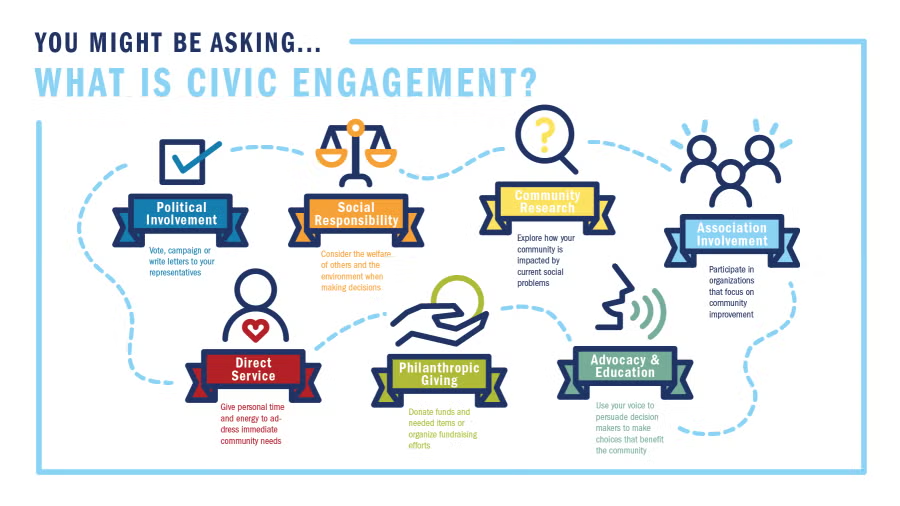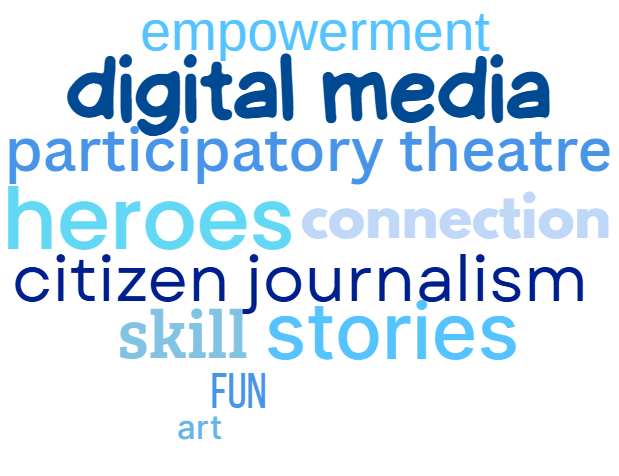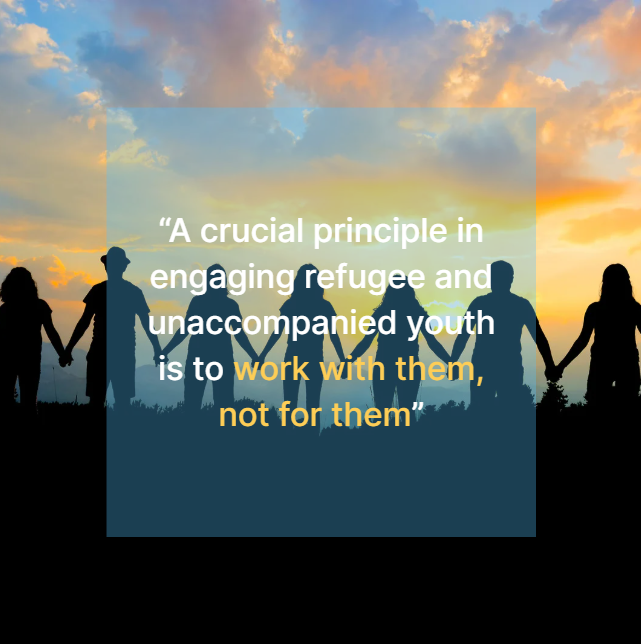6. Civic engagement
Active Civic Engagement for Unaccompanied Young People on the move
Description:
Active civic engagement refers to the meaningful participation of individuals in activities and processes that aim to improve their communities, represent their interests, and influence decisions that affect their lives. For unaccompanied young people—particularly those with refugee or migrant backgrounds—civic engagement is not only a fundamental right, but also a powerful tool for social inclusion, personal empowerment, and integration into their host societies.
This training course is designed for professionals working with unaccompanied minors and young people on the move, equipping them with the knowledge, tools, and strategies needed to foster civic awareness and participation among this vulnerable yet resilient group. Participants will explore the barriers refugee youth often face when trying to engage civically—such as legal restrictions, trauma, discrimination, and lack of access—and learn how to create safe, inclusive, and empowering environments that support young people in becoming active contributors to their new communities.
Aim:
The aim of this course is to equip professionals with the knowledge, tools, and strategies to support young refugees and unaccompanied minors in understanding and practicing civic engagement. It emphasizes the role of civic participation in fostering social inclusion, empowerment, and a sense of belonging, regardless of a young person’s legal or migratory status. Participants will learn how to introduce the concept of civic engagement in youth-friendly and culturally sensitive ways, using practical and inclusive approaches. The course also explores how civic involvement can help young people heal from displacement-related trauma, build confidence, and take on active roles within their communities. Ultimately, the training empowers professionals to help youth move from the margins to the center as engaged, informed, and contributing members of society.
Learning outcomes:
By the end of the module, participants will:
- Understand the importance of civic engagement for young refugees and unaccompanied minors.
- Be able to explain civic rights and responsibilities in youth-friendly and inclusive ways.
- Recognize barriers to civic engagement for this group and how to address them.
- Be equipped with strategies and tools to foster civic empowerment in their practice.
- Develop a mini civic engagement plan tailored to young people on the move.
Understanding Civic Engagement in the Migration Context
What is civic engagement?
Civic engagement refers to the ways in which individuals participate in the political, social, and community life of their society to help improve conditions for others or shape the future of their communities. It involves both political and non-political actions that people take to influence public decision-making, advocate for change, and support their communities.
It is essential for a healthy democracy and vibrant civil society. It empowers individuals to have a voice in how their communities are governed, helps ensure accountability, and fosters a sense of belonging and shared responsibility.

Key Forms of Civic Engagement:
- Voting in elections
- Volunteering for community organizations or causes
- Attending public meetings or town halls
- Advocating for policies or reforms (e.g., through petitions, protests, or contacting officials)
- Joining community groups or civic organizations
- Participating in local decision-making, such as school boards or neighborhood councils
- Educating oneself and others about social and political issues
The Right to Participate Beyond Legal Status
Even if unaccompanied young refugees and migrants do not yet have full legal rights in their host country, they still possess a voice and the right to participate in civic life. Civic engagement is not limited to formal acts like voting; it encompasses a broad spectrum of activities where individuals contribute to and shape their communities through both political and non-political means.
Why Participation Matters? | |
|---|---|
 Expression and Belonging | Civic engagement provides young people with opportunities to express their views, share their experiences, and feel a sense of belonging—physically, legally, emotionally, and socially. |
 Agency and Empowerment | By participating in community activities, advocacy, volunteering, or local initiatives, young refugees exercise agency and develop skills that empower them to influence decisions affecting their lives and those of others. |
 Building Inclusive Communities | Host societies benefit when all residents, regardless of legal status, can contribute their perspectives and talents. This inclusive approach helps foster mutual understanding, social cohesion, and innovative solutions to community challenges. |
Practical Ways to Participate | |
|---|---|
 Volunteering | Getting involved in local projects, environmental clean-ups, or charity events. |
 Community Dialogue | Joining youth groups, attending public meetings, or participating in cultural exchanges. |
 Advocacy and Storytelling | Sharing personal stories, raising awareness about refugee experiences, or supporting causes through social media and community campaigns. |
 Informal Leadership | Taking initiative in peer groups, helping organize activities, or supporting others in similar situations. |

The Role of Professionals
Professionals working with unaccompanied young people should emphasize that civic engagement is about more than legal status—it is about being part of a community and having the right to help shape it. Creating safe spaces for dialogue, encouraging participation, and recognizing young people’s contributions are essential steps toward fostering active citizenship, even before full legal rights are granted.
Civic engagement means working to make a difference in the civic life of our communities and developing the combination of knowledge, skills, values and motivation to make that difference. All young people—regardless of their migration status—have the right to be heard and to participate in building the society they live in. Their involvement is both a right and a vital resource for vibrant, inclusive communities.

The Role of Professionals
For unaccompanied minors and young people on the move, civic engagement holds transformative potential. Often navigating new systems and unfamiliar social contexts, these youth may feel isolated, invisible, or powerless—especially when facing legal or structural barriers. Civic engagement offers a path to visibility, voice, and agency, helping them feel not just present in their host society but truly included in shaping it.
Participating in civic life—whether through creative expression, peer support initiatives, or community service—enables refugee and migrant youth to claim their place, share their perspectives, and contribute meaningfully to society. It strengthens their sense of belonging, fosters resilience, and can challenge dominant narratives that often portray them only as vulnerable or dependent. Supporting their civic engagement affirms their rights as young people, regardless of legal status, and promotes more cohesive, inclusive communities for all.

Interactive Activity Ideas
“My Community, My Voice”: Group brainstorm of what it means to belong in a society — physically, legally, emotionally, and socially.
Barriers and Bridges to Engagement
Unaccompanied young refugees and migrants face a range of obstacles that can limit their civic participation.
Legal Barriers
Many young people on the move lack citizenship or permanent residency, restricting their ability to vote or formally participate in decision-making processes. Even when legal rights exist, uncertainty about their status or fear of negative consequences may inhibit involvement.
Linguistic Barriers
Limited proficiency in the host country’s language can make it difficult to access information, communicate with others, and understand civic processes. This often leads to feelings of isolation and can discourage participation.
Psychosocial Barriers
Experiences of trauma, discrimination, and the stress of resettlement can undermine confidence and motivation. Fear of authority, rooted in past experiences, may persist and deter engagement.
Internalized Marginalization
Besides, many refugee and migrant youth internalize feelings of marginalization, questioning their right or ability to participate in civic life. This mindset—“Who am I to engage?”—can appear. It might arise from previous experiences in countries where youth or marginalized groups were discouraged or even punished for speaking out. Also from repeated exclusion or lack of recognition in the host society, leading to diminished self-worth and reluctance to participate. Cultural or familial expectations that discourage challenging authority or public involvement also cause this effect.

Overcoming barriers
The Role of Adults Allies and Mentors
Supportive adults play a crucial role in overcoming these barriers. They provide guidance and encouragement, making it easier for youth to understand and navigate unfamiliar systems. By including young people in decision-making, adults show them the value of their input, which helps build their confidence and sense of control. Additionally, adult allies advocate for fair policies that ensure the voices of unaccompanied youth are heard and respected, creating a more inclusive environment for everyone.
How to Create Safe Spaces for Participation?
- Cultural Sensitivity: Recognize and respect diverse backgrounds, experiences, and perspectives.
- Language Support: Provide interpretation, translation, and accessible materials to ensure understanding and participation.
- Emotional Safety: Establish ground rules for respect and confidentiality, and address trauma-informed needs.
- Opportunities for Leadership: Encourage youth to take on leadership roles in projects or discussions, reinforcing their value and capabilities.
- Community Partnerships: Collaborate with ethnic community-based organizations (ECBOs) and youth groups to bridge gaps and build trust.
- Creating bridges: it requires intentional, sustained effort from professionals, communities, and institutions. By addressing barriers and empowering youth, we help unlock their potential as active, valued members of society.
Barrier Type | Examples | Bridges/Supports |
|---|---|---|
 Legal | No voting rights, uncertain status | Non-formal participation, advocacy, information |
 Linguistic | Limited language skills, lack of translation | Language classes, interpreters, bilingual mentors |
 Psychosocial | Trauma, fear, low confidence | Trauma-informed care, peer support, encouragement |
 Internalized Marginalization | “I don’t belong,” low self-worth | Role models, positive feedback, leadership roles |
 Structural | Lack of access, unfamiliar systems | Orientation, accessible materials, ECBO support |

Interactive Activity Ideas
In small groups, identify key barriers refugee youth face and brainstorm ways to remove them through program design, partnerships, and youth-friendly methods.
Communicating the Importance of Civic Engagement to Youth
Youth-Friendly Messaging: What’s in it for them?
To engage young refugees and migrants effectively, messages about civic participation should be relevant, accessible, and motivating. Framing civic engagement as an opportunity can enhance their interest.
Personal empowerment is crucial, as participation gives youth a voice and the ability to create change in their lives and communities. It also supports identity-building by allowing them to explore who they are and connect with others.
Moreover, skill development is a key benefit, helping youth gain valuable skills like communication and leadership. Finally, emphasizing the fun and connection in civic engagement makes it enjoyable and a great way to meet new people. By focusing on these aspects, messages can resonate more with young refugees and migrants, encouraging their active involvement.
Using stories as relatable role models can significantly inspire young refugees and migrants. Sharing real-life examples of individuals like Mohammad Shehadat, a Syrian refugee who founded the Youth for Peace Initiative, illustrates how young people can become leaders, advocates, and changemakers. Highlighting youth-led organizations and councils where refugee youth support each other further emphasizes the power of peer inspiration. Additionally, featuring local heroes within the community demonstrates that leadership and engagement are achievable for anyone, regardless of their background or legal status.
Incorporating non-verbal and creative communication methods can also enhance engagement. Art-based approaches such as painting, music, photography, and crafts allow young people to express complex feelings and ideas, especially when language barriers exist. These creative outlets foster inclusion and support mental well-being.
Digital media platforms like social media, videos, and podcasts enable youth to share their stories, organize campaigns, and connect with broader audiences, transforming them from consumers to creators of civic content. Participatory theatre offers a safe space for youth to explore social issues, practice advocacy, and build confidence in public speaking and collaboration. Lastly, encouraging citizen journalism empowers young people to document community issues or successes through photos, blogs, or short films, amplifying their voices and perspectives. Together, these strategies create a supportive environment that encourages active participation and leadership among young refugees and migrants.

Key Takeaway
Communicating the importance of civic engagement to young refugees and migrants means meeting them where they are—using creative, empowering, and relatable approaches that connect civic action to their identities, interests, and aspirations. By highlighting real role models and leveraging digital and artistic tools, professionals can inspire youth to see civic engagement as both meaningful and enjoyable.
Tools and Approaches for Engagement
This section explores a range of practical, youth-centered tools and methods that professionals can use to foster civic engagement among unaccompanied minors and young refugees. The focus is on participatory, empowering approaches that center young people’s voices and respect their lived experiences. The tools presented are adaptable across different contexts, including low-resource environments and settings where legal or social barriers to participation exist.
TOOL/APPROACH | DESCRIPTION | BENEFITS |
|---|---|---|
 Youth Councils | Youth councils provide a platform for young people to express their opinions and influence decisions on issues that affect their lives. By involving refugee youth in local or organizational councils, these councils promote representation and accountability while fostering leadership skills and a sense of civic responsibility. | Youth councils empower young people by giving them a voice in community matters, enhancing their leadership abilities, and encouraging active participation in civic life. |
 Peer Mentoring | Peer mentoring involves creating safe and supportive relationships between young people, where they can encourage each other to engage in civic activities. This approach fosters solidarity, role modeling, and trust-building among peers, making it easier for youth to participate. | Peer mentoring helps build a sense of community and belonging, as young people support one another in their engagement efforts, leading to increased confidence and motivation. |
 Storytelling Circles | Storytelling circles offer structured and supportive spaces for young people to share their personal experiences and narratives. This method allows participants to surface shared struggles and aspirations, fostering empathy and a collective identity among youth. | By sharing their stories, young people can validate their experiences, build connections with others, and develop a stronger sense of community and understanding. |
 Participatory Photography | Participatory photography, such as the PhotoVoice method, empowers youth to document their realities and communicate important messages through visual means. This approach is particularly effective for those who may face language or literacy barriers, allowing them to express themselves creatively. | This tool validates the identities of young people, enhances their confidence, and enables them to share their perspectives with a wider audience, fostering community connections. |
 Projects for Social Change | Engaging youth in collaborative action projects, such as awareness campaigns, community service activities, and art initiatives, provides tangible ways to introduce civic engagement. These projects allow young people to work together on issues they care about, such as anti-discrimination or access to education. | These collaborative efforts help young people see the impact of their actions on the world around them, reinforcing the idea that their voices and efforts matter in creating positive change. |
 Digital Participation | Digital tools play a crucial role in engaging refugee youth, who may be more connected online than offline. This includes using social media platforms to raise awareness, participate in online consultations, and engage in youth forums organized by NGOs or community networks. | Digital participation empowers youth to advocate for causes, share their experiences, and connect with others, while also providing opportunities to learn about digital safety and responsible engagement. |
How to Support the Engagement
A crucial principle in engaging refugee and unaccompanied youth is to work with them, not for them. This means:
- Practicing co-design, where youth are involved in shaping the activities, setting goals, and making decisions.
- Avoiding tokenism by creating authentic roles and responsibilities in projects and decision-making processes.
- Facilitating rather than directing—acting as guides, allies, and resource providers while allowing youth to lead.
This approach builds ownership, trust, and sustainability, ensuring that engagement is meaningful and not just symbolic.

Key Takeaway
There is no one-size-fits-all. Engagement must be adapted to each young person’s identity, trauma background, and strengths.
Planning for Action
This closing unit guides professionals in translating what they’ve learned into practical, youth-led actions. It emphasizes how to start small, build trust, and lay the groundwork for sustainable engagement—even in challenging or uncertain contexts.
How to initiate engagement through low-barriers, small actions
Civic engagement doesn’t have to begin with large campaigns or formal structures. For many unaccompanied minors and refugee youth, starting with small, accessible activities helps build confidence and interest. Examples include:
- Asking youth to help design a poster for a community event.
- Creating a simple idea board where young people can post suggestions for
- Encouraging reflection on what they’d like to improve in their immediate environment (e.g., school, shelter, neighborhood).
These small steps reduce pressure, meet youth where they are, and allow engagement to develop naturally over time.
Co-creating with Youth: Setting Goals Together
Co-creating with youth involves setting goals together, which fosters shared ownership of the planning process. Professionals are encouraged to facilitate open conversations with young people about their interests, concerns, and hopes. Utilizing participatory tools such as mind-mapping, visual timelines, or storyboards can help youth articulate and set their goals effectively. It is essential to encourage them to define what success means to them, rather than relying solely on adult or institutional perspectives. This collaborative approach not only builds trust but also ensures that the goals are relevant to the youth, enhancing their sense of agency and autonomy.
Moreover, sustainability and follow-up are crucial for ensuring that civic engagement is not just a one-time activity. Professionals should incorporate regular check-ins, feedback loops, and moments of celebration to maintain motivation among youth participants. Identifying support systems and allies, such as youth workers, local NGOs, and mentors, can provide ongoing assistance beyond the initial activity. Additionally, considering ways to scale or connect actions to larger youth networks, civic platforms, or community events can further enhance the impact of their efforts. By emphasizing sustainability, youth can view their contributions as ongoing and integral to their communities, rather than isolated experiences.
Final task
Objective: Draft a short, realistic plan to introduce or enhance civic engagement with one or more young people you work with.
Your plan should include:
- Who you will engage (e.g., an individual youth, a small group, newly arrived minors)
- What initial activity or topic you will explore (e.g., community need, creative idea, awareness theme)
- How you will introduce it (e.g., through a group session, informal conversation, co-creation tool)
- Support and resources you might need (e.g., space, materials, interpreters, local contacts)
- How you’ll follow up to ensure continuity and celebrate progress
Encourage participants to keep the plan short and simple, focusing on achievability and youth involvement. This task helps shift the mindset from training to action—and plants the seed for real civic engagement experiences.
Self-Reflection section
- Reflect on your current practice:
Do you tend to design youth engagement activities for young people, or with them? What might you change based on what you’ve learned in this unit? - Think of a young person you work with who might benefit from a storytelling or photography project. What would you need to put in place to make that activity safe, inclusive, and empowering?
Additional Reading and Sources
- Catholic Legal Immigration Network, Inc. (2020). Increasing refugee civic participation: A guide for getting started [PDF]. https://www.cliniclegal.org/sites/default/files/2020-01/Increasing%20Refugee%20Civic%20Participation%20A%20Guide%20for%20Getting%20Started.pdf
- Church World Service. (2020). Civic engagement toolkit [PDF]. https://cwsglobal.org/wp-content/uploads/2020/08/CWS-Civic-Engagement-2020.pdf
- UNESCO. (2023, June 20). From Syrian refugee to global youth leader: The inspiring story of Mohammad Shehadat. https://www.unesco.org/en/articles/syrian-refugee-global-youth-leader-inspiring-story-mohammad-shehadat
- URBACT. (n.d.). A short discussion note on civic participation for migrants and refugees. https://urbact.eu/articles/short-discussion-note-civic-participation-migrants-and-refugees
- Victoria University Library. (n.d.). Journal articles – APA 7th referencing. Victoria University. https://libraryguides.vu.edu.au/apa-referencing/7JournalArticles1
